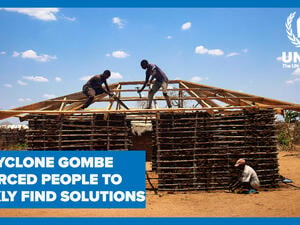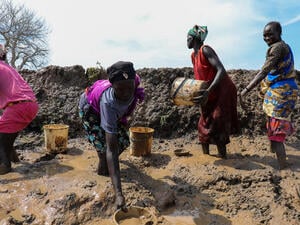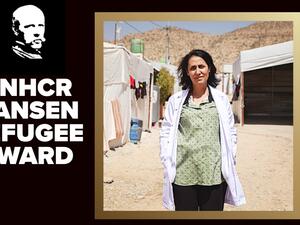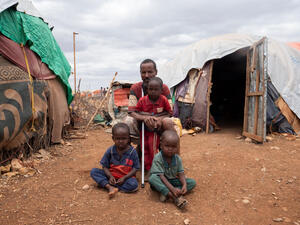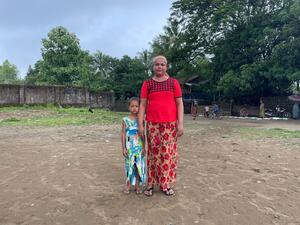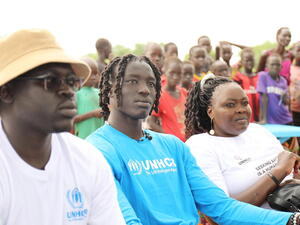Azerbaijan closes last of emergency camps
Azerbaijan closes last of emergency camps

A family of displaced people wait to move to their new home in a government-built settlement.
BAKU, Azerbaijan, February 7 (UNHCR) - In 1993, Gulshan Aghayeva was forced to flee from her home region of Zangilan in south-west Azerbaijan as conflict over the enclave of Nagorno Karabakh escalated. She found shelter in one of 12 emergency camps set up in other parts of Azerbaijan to cope with the growing number of internally displaced people (IDPs).
Aghayeva probably thought she would only have to stay a few months at the Galagain camp in east-central Azerbaijan's Sabirabad district. She and her relatives ended up spending 14 years there; living in a shabby mud-brick building with a leaking roof, only one light bulb and a small stove.
The summers were brutally hot while the stove provided insufficient heat during the bitterly cold winters. On top of that, the water supply was sporadic and employment opportunities for Aghayeva and her family were scarce.
But things finally changed for the better last December, when the government closed two emergency IDP camps at Sabirabad and Saatli and moved some 10,000 residents into new, vastly improved, housing in Fizuli district. This was the culmination of a government commitment launched in 2004 to close the 12 sub-standard emergency camps and move the IDPs to decent accommodation.
"The living conditions in our new home are much better than in Sabirabad," a happy Aghayeva said. "We now have space for our whole family and are closer to our home," she added. The south-west district of Fizuli is closer than Sabirabad to Zangilan, which is under the control of Armenians and has been renamed Kovsakan.
The dispute with Armenia over Nagorno Karabakh in the early 1990s left more than 500,000 people displaced in Azerbaijan, with around 100,000 of them housed in the 12 emergency camps at the height of the crisis. Most were set up in the south and east of the country with the help of the UN refugee agency, which helped to coordinate the international humanitarian response in Azerbaijan.
But the camps were never expected to be permanent. Conditions were harsh and they only got worse over the years. Taking this into consideration as well as the uncertainty about the return home of the IDPs, the Azerbaijan authorities in 2004 announced plans to close the emergency camps and build new settlements for the IDPs.
Later that year, five camps were closed in Bilasuvar district, followed by another four camps in the western districts of Barda and Aghjabadi in 2006. Last September, the government closed the first of two camps in Saatli. With December's closure of the last two camps, some 11,800 IDP families, or nearly 50,000 people, have been resettled.
The closure of the IDP camps is a major achievement for the government. "The government of Azerbaijan is to be congratulated for its substantial efforts to close the tented camps and relocate IDPs to settlements with improved living conditions," UNHCR Representative to Azerbaijan William Tall said.
But despite a fast-growing economy and political stability in recent years, the authorities still rely on the continuing help of organizations like UNHCR in assisting Aghayeva and other needy and vulnerable IDPs.
She and her family receive a small monthly cash allowance from the government as well as food and subsidized utilities. Despite this support, Aghayeva and tens of thousands of other IDPs find it a struggle to make ends meet.
"Significant challenges remain in terms of creating communities and employment in the new settlements, as well as improving the conditions of thousands of IDPs living in sub-standard conditions in urban collective settlements," Tall said. "It is also equally important for the international community not to neglect the extent of the problem," he added.

Some of the solid new houses that the IDPs are moving into.
UNHCR, which has been playing a major humanitarian assistance role in Azerbaijan since 1993, is actively engaged in helping the government improve the living conditions and economic prospects for the IDPs. The refugee agency continues to be the focal point for IDPs in the country.
It manages programmes aimed at complementing the State Programme on the Improvement of Living Conditions for IDPs. These focus on advocacy, legal assistance and supporting government aspirations for returning the displaced home in the framework of a future peaceful settlement to the dispute over Nagorno Karabakh.
By Nathalie Tagwerker in Baku, Azerbaijan

